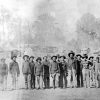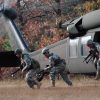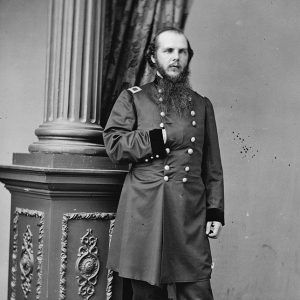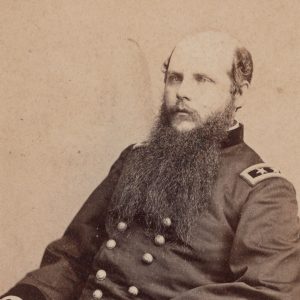calsfoundation@cals.org
John McAllister Schofield (1831–1906)
A Union general during the Civil War, John McAllister Schofield commanded the Army of the Frontier in northwestern Arkansas and southwestern Missouri. While Schofield’s military experience in Arkansas was limited, his efforts to organize Union troops in Missouri helped turn back multiple Confederate attempts to seize the state. These experiences helped prepare him for his role after the war as the commanding general of the U.S. Army.
Born on September 29, 1831, in Gerry, New York, Schofield was the son of the Reverend James Schofield and his first wife, Caroline McAllister Schofield. The family moved to Illinois, where Schofield’s father eventually founded a congregation in Freeport. John attended local schools and, at the age of sixteen, obtained work as a surveyor in Wisconsin. He worked the following year as a teacher in Illinois.
Receiving an appointment to the U.S. Military Academy, Schofield arrived in West Point on June 1, 1849. He graduated in 1853 and received a commission as a second brevet lieutenant in the Second United States Artillery with a posting to South Carolina, followed by Florida. Serving in various posts in that state, he became ill with dysentery and was sent to Virginia to recover. Returning to West Point in late 1855, Schofield taught philosophy and, in 1857, married Harriet Bartlett, the daughter of his commanding officer. The couple would have five children, three of whom lived to adulthood.
In 1860, Schofield took a leave of absence from the army and received a position on the faculty of Washington University in St. Louis. While living in that city, the secession crisis began, and he worked with Captain Nathaniel Lyon to secure the arms contained at the Federal arsenal. Schofield mustered in thousands of troops and was appointed as Lyon’s adjutant general and chief of staff with the rank of major. He also held a commission in the First Missouri Infantry. During the Battle of Wilson’s Creek, Schofield led an attack by an Iowa unit; he received the Medal of Honor in 1892 for the action.
Schofield returned to St. Louis after the battle and converted his infantry regiment into an artillery unit. On November 21, 1861, he was appointed as brigadier general of volunteers and took several administrative roles over the course of the next year. He organized and took command of the Army of the Frontier in late 1862. Through his organizational efforts, the army consisted of three divisions led by Brigadier General James Blunt, Missouri Militia Brigadier General James Totten, and Brigadier General Francis Herron. Schofield led his army against Confederate forces under the command of Major General Thomas C. Hindman in the Action at Oxford Bend on the White River on October 28, 1862, forcing the Southerners to retreat back to the Arkansas River Valley. Becoming ill in late November 1862, Schofield turned over command of the army to Blunt and missed the Battle of Prairie Grove.
He received an appointment to the rank of major general on November 29, 1862, but the rank expired in 1863 when the U.S. Senate failed to confirm it. Schofield was promoted to major general on May 12, 1863, and it was backdated to his original appointment date of November 29. While waiting on the promotion, Schofield spent about a month commanding a division in Tennessee but was sent back to take command of the Department of Missouri once he officially became a major general.
In early 1864, Schofield returned to the Western Theater and assumed command of the Department of the Ohio, as well as the Army of the Ohio. He led the army in the Atlanta Campaign and through the end of the war in the west, including the Battles of Frankin and Nashville. The Army of the Ohio also participated in the Carolinas Campaign that saw the surrender of the Confederate Army of Tennessee. Later in life, Schofield claimed credit for the final terms of surrender agreed upon by Major General William Sherman (US) and General Joseph Johnston (CS).
Remaining in the army after the war, Schofield traveled to France in 1865 to negotiate a withdrawal of French troops from Mexico. Returning to the United States, he commanded Reconstruction forces in Virginia before serving as secretary of war for most of the final year of the President Andrew Johnson administration. Schofield held various posts in the 1870s and 1880s, including command of both the Departments of Missouri and the Pacific, an assignment to visit the Hawaiian Islands, and commandment of West Point. He served as General-in-Chief of the U.S. Army from August 1888 to September 29, 1895. In 1895, he received a final promotion to lieutenant general.
Schofield’s first wife, Harriett, died in 1888, and in 1891, he married Georgia Wells Kilbourne. The couple had a daughter in 1897. Schofield died on March 4, 1906, and is buried in Arlington National Cemetery. Schofield Barracks in Hawaii are named in his honor.
For additional information:
Heitman, Francis B. Historical Register and Dictionary of the United States Army, 1789–1903. Vol. 1. Washington DC: U.S. Government Printing Office,1903.
In memoriam, companion Lieutenant-General John McAllister Schofield … commander-in-chief of the Order 1899–1903. Washington DC: Press of Gibson Brothers, 1908.
Schofield, John M. Forty-Six Years in the Army. Norman: University of Oklahoma Press, 1998. Original edition online at https://www.perseus.tufts.edu/hopper/text?doc=Perseus%3Atext%3A2001.05.0131 (accessed June 6, 2024).
Searles, Harry. “John McAllister Schofield—Facts.” American History Central. https://www.americanhistorycentral.com/entries/john-mcallister-schofield-facts/ (accessed June 6, 2024).
Shea, William L. Field of Blood: The Prairie Grove Campaign. Chapel Hill: University of North Carolina Press, 2009.
David Sesser
Southeastern Louisiana University


 John McAllister Schofield
John McAllister Schofield  John McAllister Schofield
John McAllister Schofield 



Comments
No comments on this entry yet.